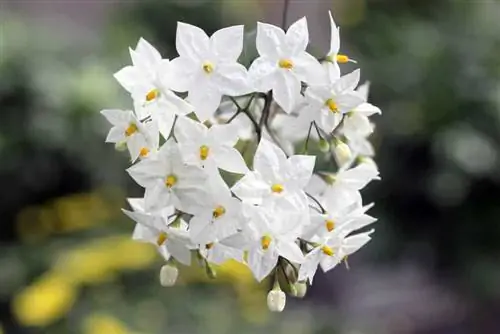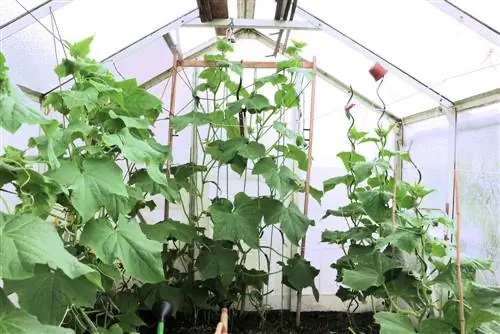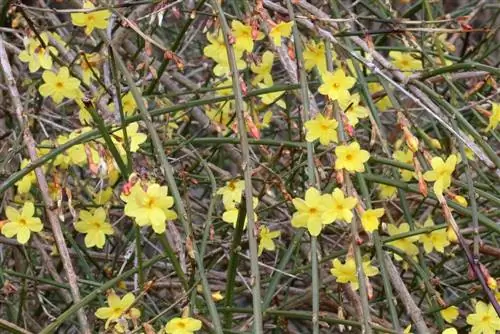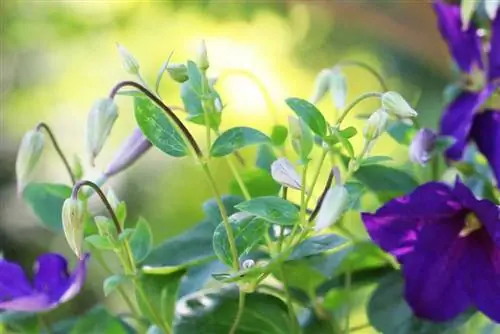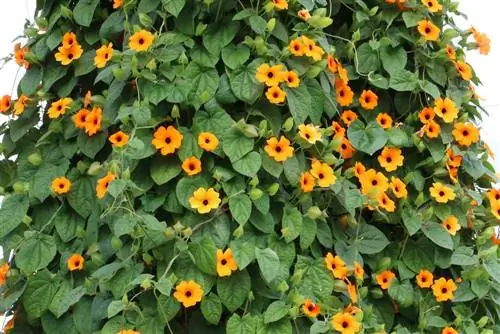- Author admin [email protected].
- Public 2023-12-17 03:39.
- Last modified 2025-06-01 06:48.
The climbing or summer jasmine (botanically Solanum jasminoides) impresses above all with its extremely beautiful flower shape and with this it greatly enhances every garden, every balcony and every terrace. In addition, its beautiful white flowers exude a very pleasant and sweet scent that lasts throughout the entire flowering period - i.e. until the first frost.
The summer jasmine is a real feast for the eyes, which not only visually enhances the garden, but also creates a unique, summery and pleasant ambience thanks to its scent. However, it is good to know that the unique scent of flowers only spreads after sunset. But that is not the only reason that has made summer jasmine one of the most popular and sought-after climbing plants. Because summer jasmine belongs to the climbing plant family and grows extremely quickly - even in a pot.
During one growing season, climbing jasmine can grow up to four meters high. This means that the plant not only looks great in the garden, but also quickly protects it from prying eyes from outside.
The jasmine can be easily grown from seeds of the plant in spring or is available as a small or larger plant in many garden centers at the beginning of spring. Climbing jasmine originally comes from the tropics, but is still very hardy and robust. This was ensured by decades of successful breeding, which adapted the climbing jasmine very well to the German climate. Unfortunately, this does not protect summer jasmine from pests such as aphids. These are the ones who really love to eat the pretty and fragrant plant.
Diseases and pests
Unfortunately, as already mentioned, summer jasmine is very susceptible to pests such as aphids. These spread very quickly on the leaves and flowers of the plant, especially in summer when it is quite dry. However, if you as a gardener are quick and tackle the pests directly, the plague can usually be contained and ended before it actually breaks out. And often even simple and gentle home remedies are suitable for this, which you only have to spray occasionally on the leaves of the plant.
In addition to aphids, other possible pests that you have to deal with in the garden include:
- Ants
- Caterpillars
- Spider mites
- Potato beetle
- whiteflies
- Snails
- roundworms
Typical diseases that can affect climbing jasmine are, however, often:
- Mildew
- Mold (rare)
- Fungal infestation
- Rot (e.g. of the roots)
Suitable home remedies to get rid of pests and usually various diseases include:
- mild soapy water - rinse the entire plant with it
- to cover the earth with coffee grounds
- Garlic - put in the soil (prevents)
- Onion decoction - add to the soil above the roots
- Thyme (for ants)
Incidentally, the plants should not be treated just once, but if there is a pest or disease infestation, they should be treated regularly with the appropriate products for several weeks.
Of course, you can also help pests and diseases with special plant protection products, such as those available in specialist shops. Here too, climbing jasmine is relatively robust - although you should definitely not overdo it with the amounts of chemical agents used. Climbing jasmine is not indestructible.
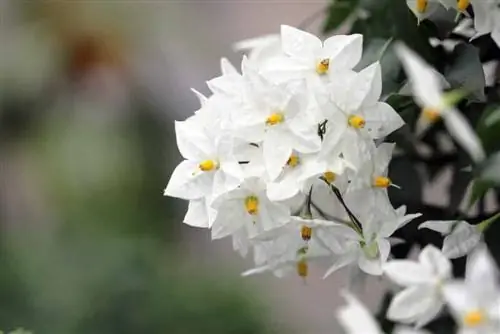
Away from the aphid plague, summer jasmine is actually very easy to care for. It can withstand numerous diseases for a long time and does not demand too much from its owner when it comes to raising and caring for it. All it requires is a sunny and wind-protected place where it can grow and soil that is not completely lacking in nutrients. However, jasmine doesn't really need many nutrients. But: the more nutrient-rich the soil, the more magnificently the plant will grow and the more beautiful the flowers will be.
Overview
- preferably sowing at the end of February to March
- Flowering time is in late summer
- prefers a sunny, warm and wind-protected location
- Basic fertilization in spring is recommended
- should be fertilized once a week
- likes it moist and should be watered a lot
- the amount of water should be steadily reduced in autumn
- is hardy
- If the winter is harsh, it may need to be warmed up with lukewarm water every now and then
The vegetation cycle in detail
The summer jasmine is relatively undemanding, but it should be provided with everything it needs during cultivation and also in spring - for example after overwintering - through nutrient-rich soil or regular fertilization. In addition, even if the jasmine is hardy, it doesn't hurt to repot it for the winter and store it in a warm place. In this case, at best, you should only bring him back into the open after the Ice Saints. Because if the jasmine has spent the winter in the warm, it might not survive the sudden change unscathed.
- the climbing jasmine should only be cut back after the flowering period and therefore in late autumn
- When cutting, the old shoots should remain standing (at least 3 cm) - dies if the shoots are cut too short
- thinning the plant is often enough
- The roots should be protected when overwintering outdoors (e.g. with a plastic bag)
- Conclusion: A plant for every garden situation?
Summer jasmine is a popular climbing plant that can enhance any garden and has numerous positive properties. The fact that it is relatively easy to care for and hardy is just one of them. The only disadvantage is its high susceptibility to aphids. Since this plague can also be quickly brought under control with the right knowledge and the right means, this “disadvantage” does not outweigh the advantages that climbing jasmine has to offer.
Care
The climbing jasmine is not hardy and is therefore only suitable as a container plant that spends the summer outside and has to be put away in the winter. Alternatively, it can also be kept in a winter garden all year round. It should be placed in a place that is as sunny or partially shaded and warm as possible, where it will grow to be several meters high if it is well cared for. As a container plant, it usually only reaches a height of between one and two meters, but it still needs a trellis to which it can hold on with its long shoots. The climbing jasmine blooms from May to October with small white flowers that are reminiscent of potato flowers and is therefore also called the potato bush. When grown all year round in a winter garden, it can even produce flowers in winter.
The climbing jasmine is only watered again when the top layer of potting soil has dried. However, it needs plenty of water in the summer months. As a container plant, it should also be supplied with additional nutrients; a fertilizer for flowering balcony plants is well suited for this. Because the flowers of climbing jasmine always form at the tips of the shoots, pruning can encourage these shoots to branch out again and thus form more flowers. This means that the plant remains somewhat more compact overall. Pruning can be done either in autumn or in early spring. Climbing jasmine usually only needs to be repotted after two to three years. Conventional potting soil is completely sufficient as a new substrate.
Wintering
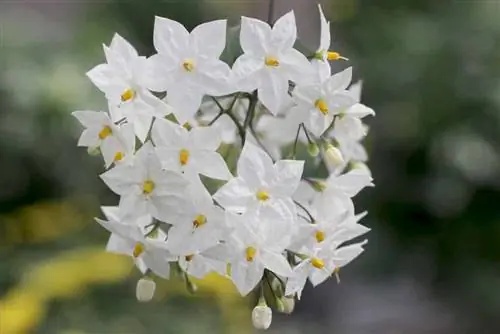
The climbing jasmine comes from warm areas in South America and is therefore not frost hardy. In the winter it needs a cool room with a temperature of around 5°C, which should be as bright as possible because it is evergreen and therefore needs light for photosynthesis even in winter. If a bright and cold room is not available, the pot can also be placed in a dark room, but in this case the plant will shed all of its leaves. In winter, the climbing jasmine is only watered a little in a bright room and hardly at all in a dark room and is no longer fertilized so that it can maintain its resting phase. If the plant has grown so large that there is no longer any suitable space for overwintering, you can cut it back heavily before putting it away.
Propagation
A climbing jasmine can be propagated quite easily through cuttings. To do this, the tips of the shoots can be cut off between spring and summer. They should be about ten centimeters long and, after the lowest leaves have been removed, are placed in pots with potting soil. This soil is initially kept only slightly moist so that the cuttings do not start to rot. Only after growth appears above ground can the amount of water be slowly increased. To get as bushy a plant as possible, it is helpful to plant several of these cuttings in one pot.
The climbing jasmine is poisonous in all parts and is therefore not or only partially suitable for households with small children and pets.

